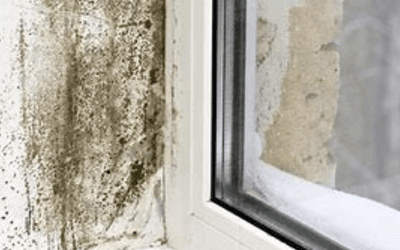- Help & Advice /
- Condensation, Damp and Mould
Condensation, Damp and Mould
How to reduce the risk in your home
Condensation is the most common type of damp, which can lead to mould in your home, that appears as a cloud of little black dots.

Condensation occurs when moist air comes into contact with a colder surface like a wall, window, mirror etc.
The air can’t hold the moisture and tiny drops of water appear. It also occurs in places where the air is still, like the corners of rooms, behind furniture or inside wardrobes.
Four ways to reduce condensation at home:
Heat your home a little more - Rooms that are not heated are more likely to get damp. While you don’t want to waste money heating rooms you don’t use, very cold rooms are more likely to get damp and mould. Set the thermostatic radiator valve to 1 in unused rooms so the radiator gives out a little bit of heat whenever you have the heating on. If you don’t have central heating, consider using a room heater with a timer and temperature control. Remember, unused rooms will need a good airing from time to time.
Let the damp air out and the fresh air in - Open your windows on a daily basis, even if just for 10 minutes to ventilate the room.
Use your trickle vents if you have them. Extractor fans are a good way to get rid of moist air and steam in your kitchen and bathroom.
They use little electricity and don’t add much to your bill. When cooking or bathing keep the door shut and your windows open.
Meanwhile, let fresh air circulate to avoid mould forming where the air is still.
Make sure there is a gap between your furniture and the walls, and give wardrobes and cupboards a good airing sometimes.
Produce less moisture - Simple things make a huge difference, like keeping lids on pans when cooking and drying your clothes outdoors whenever possible. It is not a good idea to dry your washing on your radiators.
Also, make sure your tumble dryer is vented to the outside, and avoid paraffin heaters or flue-less bottled gas heaters.
Insulate and draught-proof your home - Warm homes suffer less from condensation, so you should make sure your house is well insulated, from small measures like draught excluders, to bigger measures like loft, walls, floor insulation. Your windows and external doors could be draught-proofed. Our retrofit team might be able to find you a grant. If you have an open fire that it is NOT in use, consider using a chimney sheep to block draughts.
Other kinds of damp

‘Penetrating damp’ is caused by moisture entering the house through leaking pipes, a damaged roof, blocked gutters, gaps around window frames and cracked or defective rendering and brickwork. All these problems can be remedied.

‘Rising damp’ is due to a defective (or non-existent) damp course. This will leave a ‘tide mark’ about 1m above the floor. Fixing rising damp is a job for a qualified builder.
Newly built homes can sometimes feel damp because the water used during construction (in cement, plaster etc) is still drying out.
More tips
You can catch condensation dripping from windows with condensation channels and sponge strips (available from DIY shops). If you wipe down windows and sills in the morning this will also help, but be sure to wring out the cloth rather than dry it on a radiator. You could invest in a dehumidifier. These can help a lot but cost anything from £40 to over £200 (Running costs are approximately 5p and 14p per hour, depending on their size).
Consider using a thermometer and hygrometer (humidity sensor) to see how warm your home is and the amount of moisture in the air. Moisture in the air can cause problems and lead to condensation. A general guide is that the level of humidity should be between 30% and 60% in all rooms of your house.

If you already have mould on your walls and ceilings then you need to clean it off properly. An effective method is to start by cleaning off the mould with spray containing bleach. This will help remove the staining that persistent mould can leave behind. Leave to dry overnight and then spray the affected area with an antifungal wash and allow that to dry. Always follow the manufacturer’s instructions and consider wearing a face mask when spraying. You could also treat the affected area with a mould-resistant paint.